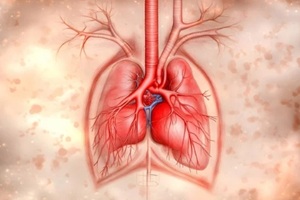 While most people are familiar with general hypertension, pulmonary hypertension is a less well-known condition that specifically impacts the arteries in the lungs and the right side of the heart.
While most people are familiar with general hypertension, pulmonary hypertension is a less well-known condition that specifically impacts the arteries in the lungs and the right side of the heart.
Understanding how pulmonary hypertension differs from regular hypertension can facilitate early recognition and prompt treatment of this serious condition.
What is Pulmonary Hypertension?
Pulmonary hypertension refers to abnormally high pressure in the pulmonary arteries, which are the blood vessels that take blood from the heart to the lungs. In a healthy person, these pulmonary artery pressures are significantly lower than systemic arterial pressures. However, for someone with pulmonary hypertension, these pressures are elevated, meaning the right side of the heart has to work harder to pump blood through the lung arteries.
There are five principal types of pulmonary hypertension, sorted by underlying cause:
- Group 1: Known as pulmonary arterial hypertension (PAH), this category involves narrowing or blockage of the pulmonary arteries. It may occur for no known reason (idiopathic) or due to genetics, certain medications or drug use, congenital heart defects, or other health conditions.
- Group 2: Secondary to left-sided heart disease, such as mitral valve abnormalities or left ventricular failure. Back Pressure in the lungs causes pulmonary hypertension.
- Group 3: Related to chronic lung conditions such as COPD, pulmonary fibrosis, or sleep apnea. Decreased oxygen causes vascular changes.
- Group 4: Caused by blood clots in the pulmonary arteries.
- Group 5: Associated with disorders such as blood cancers or sarcoidosis that affect pulmonary pressures.
Over time, the increased strain on the right ventricle can lead to its failure. Complications such as blood clots in the lungs, severe bleeding, arrhythmias, and heart enlargement may occur. Pregnancy can also be life-threatening with pulmonary hypertension.
What is Regular Systemic Hypertension?
In contrast to specifically impacting the pulmonary arteries, general hypertension involves unhealthy elevations in systemic arterial pressure. Pressure increases affect the left ventricle, as it has to work harder to pump oxygenated blood from the heart throughout the entire body’s circulation.
The most common measurement of systemic blood pressure consists of two numbers: 120/80 mmHg, for example. The systolic, or top number, reflects pressure as the heart contracts. The diastolic, or bottom number, refers to pressure as the heart relaxes between beats.
For an adult, blood pressure consistently at or above 140/90 mmHg meets the criteria for stage 2 hypertension. As with pulmonary hypertension, regular hypertension typically causes no early signs, which is why routine screening is imperative.
Diagnosing Each Condition
Since early symptoms are absent, specific testing is necessary to distinguish between pulmonary hypertension and regular systemic hypertension.
Diagnosing pulmonary hypertension involves tests such as:
 Echocardiogram to visualize the heart structure and estimate pulmonary artery pressure
Echocardiogram to visualize the heart structure and estimate pulmonary artery pressure- Chest X-ray to evaluate heart size
- Electrocardiogram to analyze electrical signals
- CT scan to check if lung blood clots are present
- Right heart catheterization to directly measure pulmonary pressures
Systemic hypertension is typically diagnosed with a simple blood pressure test. A sphygmomanometer cuff placed on the arm measures blood pressure. Confirmation requires showing elevations over multiple visits before defining a hypertension diagnosis.
Additional testing, such as urinalysis, bloodwork, or cardiac imaging, may be ordered to assess for target organ damage or contributing factors.
Treating Each Condition
The treatment approach differs between these two types of elevated blood pressure:
Pulmonary Hypertension Treatment
Since pulmonary hypertension is related to mechanically narrowed or blocked arteries, therapies aim to dilate the blood vessels. Medications such as prostacyclins, endothelin receptor antagonists, and phosphodiesterase inhibitors target pathways to relax and open up blood flow.
Oxygen therapy can ease the workload on the heart. Diuretics treat fluid retention that strains the overworked right ventricle. Digoxin and other drugs help strengthen heart contractions. For advanced disease, experimental options such as atrial septostomy or lung transplant may be considered.
Regular Hypertension Treatment
The cause of primary hypertension is typically multifactorial, such as genetics, sedentary lifestyle, obesity, and high salt intake, and so management focuses on modifying these risk factors.
 Strategies such as a heart-healthy diet, exercise, alcohol moderation, and smoking cessation help some individuals newly diagnosed with stage 1 hypertension normalize their blood pressure. Weight loss is also highly advisable for anyone who is overweight.
Strategies such as a heart-healthy diet, exercise, alcohol moderation, and smoking cessation help some individuals newly diagnosed with stage 1 hypertension normalize their blood pressure. Weight loss is also highly advisable for anyone who is overweight.
If lifestyle therapy does not bring pressures under 140/90 mmHg within three months, medication is introduced. Often, two or more agents are ultimately needed to control hypertension long term. Examples include diuretics, ACE inhibitors, ARBs, calcium channel blockers, and beta blockers, which target different blood pressure-regulating systems.
How to Distinguish Between These Types of Hypertension
While pulmonary hypertension and regular systemic hypertension both involve higher-than-normal blood pressures, keeping these important differences in mind assists with proper diagnosis and management:
- Location distinction: Pulmonary hypertension stems from the arteries specifically taking blood to the lungs, while regular hypertension impacts all systemic arteries carrying oxygenated blood.
- Baseline pressure differences: Pressures in the pulmonary arteries run far lower compared to the higher systemic arterial pressures.
- Contributing factors: Pulmonary hypertension commonly relates to pulmonary vascular changes, whereas lifestyle largely drives primary systemic hypertension.
- Consequence comparison: Pulmonary hypertension can rapidly lead to right heart failure, while regular hypertension prompts slower systemic changes.
- Treatment goals: Therapies for pulmonary hypertension focus on dilating narrowed vessels, whereas therapies for regular hypertension center on improving risk factors through diet, activity levels, weight management, and medications.
Work with Imperial Center Family Medicine for Effective Pulmonary Hypertension Care
 Hypertension is a common problem, but its effects can be extensive or even devastating if left unaddressed. Being aware of the differences between pulmonary hypertension and regular systemic hypertension empowers you to recognize warning signs, seek evaluation promptly, and comply with treatment recommendations. Catching and controlling elevated pressures, either pulmonary or systemic, is the secret to preserving heart function.
Hypertension is a common problem, but its effects can be extensive or even devastating if left unaddressed. Being aware of the differences between pulmonary hypertension and regular systemic hypertension empowers you to recognize warning signs, seek evaluation promptly, and comply with treatment recommendations. Catching and controlling elevated pressures, either pulmonary or systemic, is the secret to preserving heart function.
Imperial Center Family Medicine’s healthcare professionals have advanced training in recognizing the signs of pulmonary hypertension and constructing personalized treatment plans. Contact us today at 919-873-4437 or online to discuss any breathing or cardiac concerns and get connected to resources to determine if pulmonary hypertension evaluation is advised. Together, we can create the best path forward to manage your condition.
